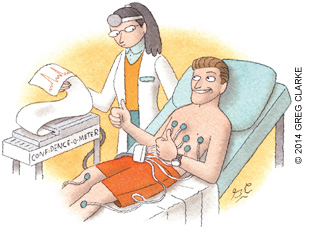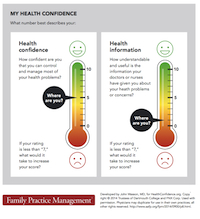
Asking patients this one question can lead to better outcomes.
Fam Pract Manag. 2014;21(5):8-12
Author disclosures: Dr. Wasson discloses that he is president of FNX Corp., which, under license with the trustees of Dartmouth College, makes the HowsYourHealth.org, HealthConfidence.org, and MedicareHealthAssess.org tools described in this article available for free to office practices. Continuous users are asked to make a donation to support development and maintenance of the tools. Large health systems, employers, community sponsors, and office practices that exceed 3,000 uses a year are charged a nominal fee.

After being hospitalized for new onset congestive heart failure, Mrs. M, a 90-year-old widow, was discharged and sent home. Over the next six months, she had two additional hospital admissions and four emergency department visits without admission. She also had seven office visits and 21 telephone contacts with her primary care physician.
Eventually, her use of health care services dropped dramatically, and she returned to her usual activities. This turn of events came about because of a relatively simple intervention: Mrs. M's primary care physician asked her to assess her understanding of her condition and her confidence in managing it, and then worked with her to achieve gains.
“Naturally I was concerned about staying on my own when I came out of the hospital,” she said. “At that time, my understanding of my heart failure was a ‘1’ on a 10-point scale and my health confidence was a ‘4.’ Now I am a ‘9’ and an ‘8.’”
This case illustrates the downside of not paying attention to health confidence. Most of Mrs. M's post-discharge medical care was potentially avoidable. But when given the opportunity to gain insight and skills, she was able to better manage her condition and remain at home.
Consider another case:
Dr. A and colleagues observed very low health confidence and disease understanding among their many disadvantaged patients with hypertension. To address this, the clinic had its medical assistants use standard scripts to educate low-achieving patients during their visits. Within a year, more than 80 percent of these patients reported that they were very confident and understood their disease. As a result, blood pressure control improved significantly.
This second case demonstrates how proactive, “upstream” evaluation of health confidence can lead to interventions that improve patient outcomes.
Engagement and health confidence
A variety of terms – such as patient activation, patient self-efficacy, self-care, and self-management – have all been used to describe a patients' health-promoting actions. We prefer the term “engagement.” The evidence-based, chronic care model illustrates the crucial connection between engagement and desirable patient outcomes.1 For example, engaged patients have better health outcomes and better health care experiences, and likely use fewer health care services and cost less.2 Clearly, a patient's level of engagement is a good thing for a clinician and patient to know.
Health confidence is an effective proxy for engagement, and practices can easily measure it using a single question: “How confident are you that you can control and manage most of your health problems?” The possible responses are “very confident,” “somewhat confident,” “not very confident,” and “I do not have any health problems.” Alternatively, patients can rate their confidence on a scale from 0 (not very confident) to 10 (very confident). A score of 7 or higher is the desired response. The question initiates self-reflection and meaningful communication between patients and health care providers. A helpful accompanying question is “How understandable and useful is the information your doctors or nurses have given you about your heath problems or concerns?” (See “A tool to assess health confidence and begin action.”)
Although we are using the term health confidence “measure” in this article, it should be thought of as more of an “action query” – that is, an assessment that results in immediate action and directly leads to improved patient engagement.
A TOOL TO ASSESS HEALTH CONFIDENCE AND BEGIN ACTION

Note: An electronic version and pdf versions in several languages are available at http://www.healthconfidence.org.
Research supporting the health confidence measure
Several recent studies illustrate the clinical validity of the health confidence measure. In 69 primary care settings, patients' reported level of health confidence was the critical measure associated with a practice's performance outcomes.3 In the 23 clinical settings where health confidence levels ranked in the bottom one-third, 38 percent of patients exercised regularly, 73 percent engaged in healthy eating and risk avoidance, and 64 percent reported control of their blood sugar (if diabetic). In the 23 clinical settings where health confidence levels ranked in the top one-third, 75 percent exercised regularly, 89 percent engaged in healthy eating and risk avoidance, and 78 percent reported control of their blood sugar.
Among 75,000 adults with chronic conditions, those who were very health confident reported many fewer adverse experiences than patients who were not as health confident.4 Patients who were not confident were much more likely to use the emergency department or be hospitalized and were more likely to claim that much of the hospital and emergency department use was unnecessary.
Patients' ratings of this single measure for health confidence are aligned with surveys based on multiple measures of their confidence to self-manage chronic conditions.4
In a cross-national study, 11 nations' rankings based on the single health confidence measure were strongly correlated with several measures of clinicians' engagement activities.4
Influences on health confidence
Practice patterns, comorbidities, and modes of administration can influence patients' reported levels of health confidence.
Low health confidence is strongly associated with low financial status and a high burden of illness.4 Persistent bothersome pain or emotional problems impede improvement in health confidence and undermine the effectiveness of care.6 Of Medicare beneficiaries studied who were health confident, more than 90 percent reported that they always take their medicines as prescribed.7 In contrast, only 75 percent who were not confident (and 60 percent who were not confident and also bothered by emotional problems) complied with medication therapy.
Health confidence ratings are often positively biased if a patient is questioned directly by an authoritative figure, such as a health professional presenting the question with a judgmental tone.7 This is often referred to as the social desirability bias. To minimize it, the presenter should avoid a judgmental tone by emphasizing the value of an honest response.
Using the health confidence measure
Offices can implement the health confidence measure in several ways:
As a vital sign for patients who have chronic conditions, health risks, or difficulty following recommended care. Six of 10 adults who have chronic conditions are not health confident, and the majority of patients who have health risks (such as not exercising, being overweight, smoking, or drinking excessively) are not confident they will make progress in the two months after they choose to reduce one of these risks.8 To identify these patients and help them get the resources they need, medical assistants can routinely ask patients about their health confidence as part of their collection of vital signs.
As part of a routine check up. For example, the Medicare annual wellness visit offers a scheduled opportunity to integrate health confidence into a patient's health check up. Both paper-based and electronic assessment methods are available. (See the Medicare annual wellness visit tools listed under “Additional resources.” )
For patients transitioning from another care setting. Depending on their burden of illness and the quality of their hospital, 12 percent to 67 percent of patients feel prepared to manage their health problems at discharge.5 Exposing inpatients to the health confidence tool could help them express their limits and concerns as they transition from the hospital and could obviate much unnecessary subsequent care.
For patients facing a new diagnosis, procedure, etc. Patients also experience significant transitions during clinic visits. New diagnoses, treatments, tests, and management decisions often disrupt a patient's health confidence.
If a patient's health confidence is high (a score of 7 to 10) and the patient has a good understanding of his or her health problems, the office can proceed with usual care.
If a patient's health confidence is low (a score of less than 7), the clinician or a staff member should follow three basic steps of motivational interviewing:9
1. Find a way to support or reinforce any progress the patient has made. For example, “I see you marked a ‘4’ on health confidence. What made you mark a ‘4’ instead of a ‘0’?” This allows the patient to reflect on some personal strengths.
2. Ask what it would take to reach a higher level of health confidence. For example, “What would you need to move from a ‘4’ to a ‘7’?” This allows the patient to identify behavioral goals that are acceptable, meaningful, and feasible rather than having the clinician suggest a goal that does not fit with the patient's values.
3. Ask which goals might be most important and how the doctor or office staff might be able to help. This allows the patient to prioritize options, and allows the practice to be clear about the support it will be able to provide. Often, patients need a plan that involves Internet or community resources that teach them about problem solving, weight loss, blood sugar control, etc. (For more information on using community resources, see “Caring for Seniors: How Community-Based Organizations Can Help.”) The support plan can be revisited, reinforced, and modified at subsequent visits.
When a patient's progress is slow, consider whether pain or emotional problems (anxiety, depression, etc.) are present. An additional intervention such as telephone outreach is often needed to help these patients achieve behavior change. The patient's response to the question “What will it take to move higher on the confidence scale?” should guide the choice of resources. The patient may need to be referred to a health coach, case manager, or a specialist in behavioral therapy. Peers who have completed a chronic disease self-management program or those who are members of community support groups may be valuable resources as well.
Reassessment and reinforcement is usually needed to improve health confidence. When health confidence becomes part of everyday clinical service, the practice will find that it is a powerful stimulus for behaviorally sophisticated actions and a useful organizing principle for more efficient and effective services.
The next “blockbuster drug”
Patient engagement has been rightfully likened to a blockbuster drug for successful management of chronic conditions and the reduction of health risks.10 However, its appropriate prescription has been limited by its vague definition. Health confidence provides a free, easy to use, actionable measure to encourage patient engagement and better practice.
Additional resources
The following resources can assist practices with assessingpatients and their health confidence:
This site provides a complete health assessment with tailoredinformation and a personal health plan for peopleage eight to 99. It also offers figures and forms related tothis article, such as the “Problem Solving” tool, which can help patients prioritizetheir problems and develop practical solutions.
This site incorporates health confidence into a paper orelectronic checkup for Medicare annual wellness visits.There is a “short form” version and a “long form” version,which automatically adds a personal health plan that theuser can share and update at any time.
This site offers a tool for clarifying and supporting the needsof patients who are frail or need palliation or hospice care.
This is a “how to” manual for health assessment in primarycare practice created by the Agency for Healthcare Researchand Quality. It offers additional links to information andcommunication technologies.
This site offers a multi-item measure for patient activationthat includes many items for patient health confidence.
Further reading:
Stewart EE, Fox C. Encouraging patients to changeunhealthy behaviors with motivational interviewing. FamPract Manag. 2011;18(3):21-25. https://www.aafp.org/fpm/2011/0500/p21.html.
Hibbard J, Lorig K. The dos and don’ts of patient engagementin busy office practices. J Ambul Care Manage.2012;35(2):129-132.
Simmons L, Baker NJ, Schaefer J, Miller D, Anders S. Activationof patients for successful self-management. J AmbulCare Manage. 2009;32(1):16-23.
